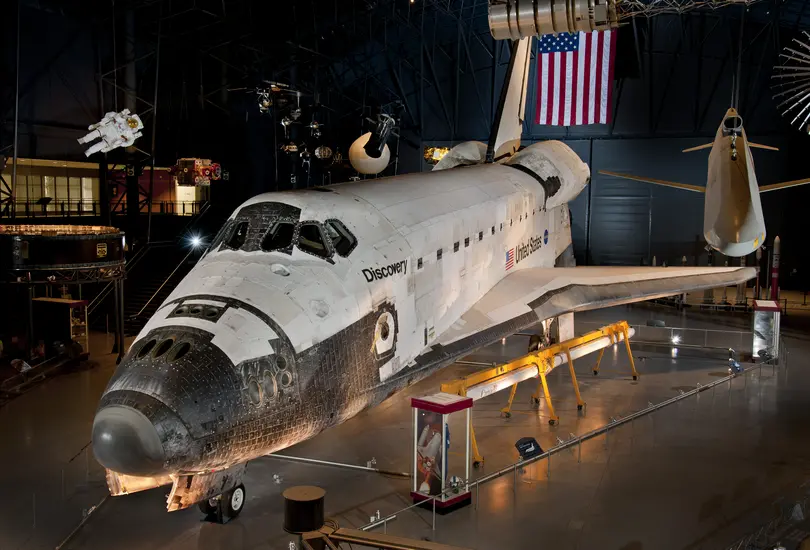
Udvar-Hazy Center
Since its opening, the National Air and Space Museum's building on the National Mall has been limited by size to the display of only a small fraction of the collection of aircraft and large space artifacts. Thousands of artifacts were forced to remain in storage.
In 1977, Don Lopez, then Chair of the Aeronautics Division, sent a memo to Director Michael Collins, suggesting that massive buildings, much larger than the new Museum, be procured at one of the regional airport facilities. He recognized that modern aircraft were generally larger, heavier, and more difficult to move by road from one location to another. Future acquisitions, perhaps as large as a Boeing 747, would require covered display space and would need to travel there without being disassembled, trucked over miles of highway, and then reassembled. Such costs would be prohibitive except in the rarest of cases. Lopez ruled out any location more than one hour's drive from the National Mall in Washington, DC. This criteria narrowed the possibilities significantly.
In 1980, Lopez and Deputy Director Mel Zisfein initiated a study to select the best candidate for an annex. Dulles Airport seemed most logical option, and after some perseverance, the Smithsonian Board of Regents endorsed the plan, and the Federal Aviation Administration offered one hundred acres of land to the south of the airport for the construction of the Dulles Annex. That was just the beginning.
In 1993, President Bill Clinton signed a law establishing an extension for the Museum at Washington Dulles International Airport in Virginia. The future companion facility, known at first as the Dulles Annex, would be the largest construction project in Smithsonian history and the only Smithsonian museum building to be constructed entirely with private funds.
-
Gen. John R. "Jack" Dailey, director of the National Air and Space Museum, performs the ceremonial ribbon cutting at the official opening of the Steven F. Udvar-Hazy Center, December 15, 2003. Looking on, left, is Joe Anderson, the associate director for the Udvar-Hazy Center and Donald S. Lopez, deputy director of the National Air and Space Museum.
The annex was renamed the Steven F. Udvar-Hazy Center for its major donor who contributed $65 million for the project. The center opened on December 15, 2003 during 100th anniversary of the Wright Brothers' first sustained, powered flight at Kitty Hawk, North Carolina. It was an extremely cold winter day, but the parking lot was full and the lines were long. In the first two weeks, the Udvar-Hazy Center welcomed more than 200,000 visitors and an additional half million came in the next three months. It quickly became the most-visited museum in Virginia, with an average of one million visitors a year.
The Center features two massive hangars. The ten-story-high Boeing Aviation Hangar displays aircraft hanging at several levels, angled as if in flight. Larger, heavier aircraft are displayed on the floor. Multi-level walkways rising some four stories high provide a wide variety of perspectives from which to view the aircraft and spacecraft on display. Glass cases display thousands of smaller items. On opening day, only 80 aircraft were on display, versus today when there are over 180. Highlights include a Lockheed SR-71 Blackbird; the Boeing B-29 Superfortress Enola Gay, which dropped the first atomic bomb during World War II; the first supersonic commercial airliner, the Concorde; and the first pressurized airliner, the Boeing 307 Stratoliner Clipper Flying Cloud.
The James S. McDonnell Space Hangar also displays objects on multiple levels. Dominating the hangar is the Space Shuttle Discovery, which is surrounded by missiles, rockets, space capsules, satellites, and small objects in display cases. The hangar opened to the public in 2004. Another highlight in the McDonnell Space Hangar include the Mobile Quarantine Facility in which the Apollo 11 astronauts stayed after their flight to prevent the possible spread of Moon contagions.
Construction of the Center continued until late 2010, when the Mary Baker Engen Restoration Hangar, the archives, collections processing unit, Emil Buehler Conservation Laboratory, and collections storage facility were completed. Visitors can now see restoration work in progress from a mezzanine overlooking the Restoration Hangar.
Although construction is completed, the Steven F. Udvar-Hazy Center is still a work in progress. More aircraft, spacecraft, and small artifacts are added regularly, and will continue to be added as more objects are restored and acquired. For more information about what's on view today, please visit the current exhibitions listing and the list of objects on display.
Learn more information about the Udvar-Hazy Center and plan a visit.





